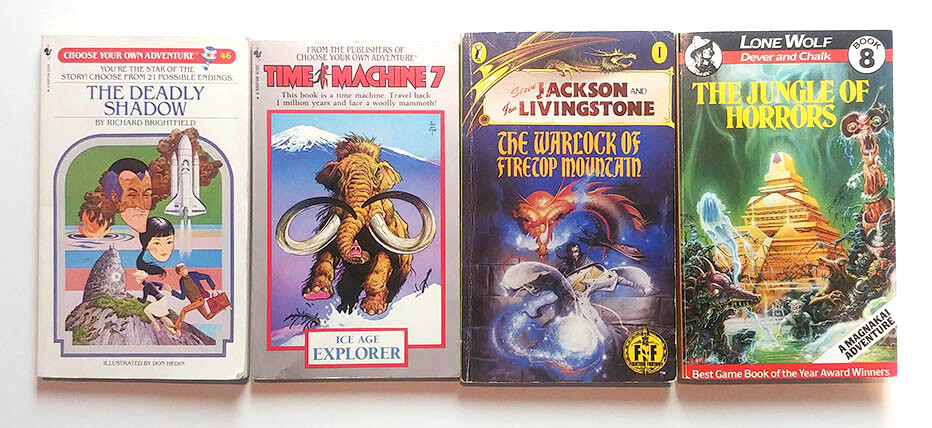Interactive storytelling has been around for a very long time. My earliest memory personally was from the Choose Your Own Adventure and Fighting Fantasy books that let children in the 80s go on adventures flicking back and forth through the pages of various stories. You were given choices along the way and depending on what path you chose through the book’s pages you would have a different adventure every time you read/played. See a few examples of these in my personal collection below. The stories in these books had many varied and interesting endings.

Ever since then, the interactive element of storytelling has skirted between books, video games, web video and now TV formats. Some of these efforts have fallen short, been slightly clunky or had mixed reviews (I’m looking at you, Night Trap). Examples that have stood out in recent years are generally websites that have an educational slant where they are teaching the user in a quiz-like format, such as the extremely well made Lifesaver. There are not many good examples where good storytelling has been at the heart of the overall experience. Netflix’s latest episode of Black Mirror, called Bandersnatch, is definitely the biggest and boldest attempt to do this on streaming TV. This is a whole new way to watch a Netflix show.
Interactive storytelling is all about asking questions, so here goes.
Is the interactive storytelling element relevant?
My first reaction when I heard that Netflix was doing an interactive version of Black Mirror was that it was just going to be gimmicky and it wouldn’t add to the story. Charlie Brooker, however, (the genius behind Black Mirror, as well as being creator, presenter and/or writer on Newswipe, Gameswipe, Screenwipe, Dead Set, PC Zone magazine and one of my personal favourites, Oink!) has been pretty smart with how he has done it. He hasn’t just added these interactive storytelling elements to any random story. He chose to base the plot around a fictional interactive video game which itself was based on a choose your own adventure style book. This gives the choice of using interactive storytelling much more relevance and allows the ideas to work on multiple levels.
Interestingly, the game in question, called Bandersnatch, is actually named after a real game from Imagine that never saw the light of day back in the 80s. If you are into retrogaming or have memories of your gaming past, you may spot that the show contains several references to 80s video game culture and one pretty big cameo that you will appreciate, particularly if you choose a certain path within the story.
Brooker handles the premise extremely cleverly (slight spoilers ahead). He doesn’t just add multiple path points to a standard story. The whole interactive storytelling premise itself is made a key plot point. Firstly, within the script he discusses the notion about how multiple timelines absolve people of guilt about their actions in one given timeline. This raises subjects such as fate, determinism and free will. Furthermore, he actually makes the main character become aware that he is being controlled by us, the viewer. This meta layering of awareness made sure that Bandersnatch wasn’t your average choose your own adventure story. One intriguing bit was when you are asked if you want to make the character Stefan show nervousness by either biting his nails or pulling on his earlobe. Whichever option you choose here Stefan manages to stop his hand from doing it. The character is aware he is being controlled and he fights against it. This is a clever way to show that Stefan was rebelling against our decisions. I’ve never seen that breaking of the fourth wall before in an interactive story.
Have Black Mirror and Netflix used the technology well?
From a storytelling perspective I think it does highlight how difficult it must be to write for interactive stories. Some of the most engaging parts of the story were when the audience didn’t expect it and weren’t asked to get involved. When you’re asking the audience to choose what happens next it can be very difficult to surprise or shock them. If the audience is making up their own story path it can often feel anti-climactic and they might just be left wondering what the other option would have led to. Also, from a technical perspective, although the streaming worked flawlessly for me, when you’re waiting to make your decision sometimes what was happening on screen felt a bit like an awkward silence that pulled you slightly out of the story. Perhaps these moments could flow slightly better. But having said all this, this is by far the best interactive storytelling experiment that I have experienced. I’m sure there will be more shows made in this way and we will see how this new form of storytelling on TV evolves.
Is interactive storytelling suited to TV in general?
The format works very well in books, as mentioned in the opening paragraph, but I can’t help but feeling that it just doesn’t work quite as well on the TV. When you read books you create all of the visuals in your own head and, particularly in a Fighting Fantasy book, you take on the role of the protagonist yourself. This works extremely well as you are making decisions that affect your own story. In Bandersnatch, however, you are watching someone else and making decisions for them, which is a very different premise. It feels slightly more contrived. When you watch a normal TV show you are watching the vision of one director and you are seeing their version of the truth. When we, the audience, are allowed to interfere then it can sometimes make the story ‘worse’.
One thing that I think also happens here is that it gets you curious about all the other paths and options that could happen, and so sometimes you make a decision you wouldn’t normally make, just to see what the alternate scenes and endings are. This can be confusing to your overall personal story arc, but it also makes the experience more about the process and less about the actual story. You become more aware of the production process as it pulls you out of the immersive experience of watching a show. Moreover, with books you can easily jump about and see what the other paths were, but in the Netflix environment you have to stick to the linear video path and often watch clips multiple times. There are often clever editing techniques to quicken these rewatches, however, such as in the Star Trek: The Next Generation episode ‘Cause and Effect’, where they replay the same story several times but slightly quicker each time.
One of my key takeaways was that I felt that the interactive element took away from the storytelling in many instances. I couldn’t help but feel slightly cheated when one of my decisions resulted in a dead end. It made me feel that my storyline wasn’t the ‘true story’. Most TV shows make you want to sit back and watch in a relaxed state and be entertained with a pre-determined story, but with Bandersnatch you have to be alert the whole time with your control in hand in order to press the right button at the right time. It’s more a game than a TV show. And there is absolutely nothing wrong with that. Viewers perhaps just have to put themselves into a gaming mentality when they start watching. It’s like Charlie Brooker’s internet TV version of the classic arcade game Dragon’s Lair. It’s interesting that we might see the terms ‘game’ and ‘show’ being intertwined more.
Whenever you give the viewer the ability to make decisions, however, particularly violent ones, there will be complaints. Bandersnatch is no different. There have been several complaints about how the show gives you the power to make the character kill someone else, quite graphically. Whatever your take on censorship, ratings and violence in video games, I think this opens up some interesting conversations about what choices should or should not be allowed in interactive storytelling. Games have led the way in this area, and with this level of user control now starting to appear on the ubiquitous TV box in everyone’s living room, I’m sure this argument will rage on.
Is it worth a rewatch?
One thing for sure is that it benefits from multiple viewings. For people who are viewing it as a TV show they might find that a little frustrating. The more you view it the more scenes you have to rewatch again and again just to get to one little alternate end scene. When viewed with a gaming mentality then yes of course you can play it as many times as you want.
Will we suddenly see a flurry of interactive Netflix shows?
Personally I don’t think so. These things must be a massive undertaking to produce. They require much more writing and project management complexity, not to mention filming more than just one show’s length. I wonder how Netflix will classify the higher viewer numbers it will possibly get due to rewatches. It probably won’t be comparable to other Netflix shows in that sense.
What other shows could Netflix make using this technology? Murder mystery shows? DIY tutorial shows? Will it cause people to fall further into their own personal echo chambers only choosing paths that they are comfortable with, or will it help tailor content to a level never seen before? It will be interesting to see how it develops, but I do think it will be a technology reserved for simpler format shows or big TV specials.
Was Bandersnatch ultimately a success?
Only you have that answer. The decision is yours.



